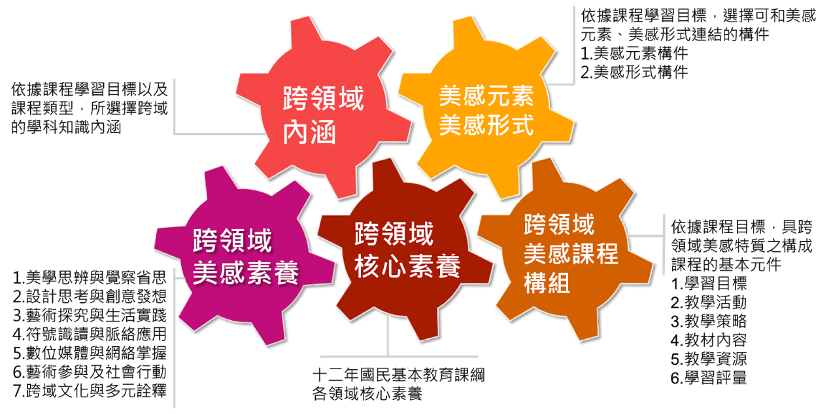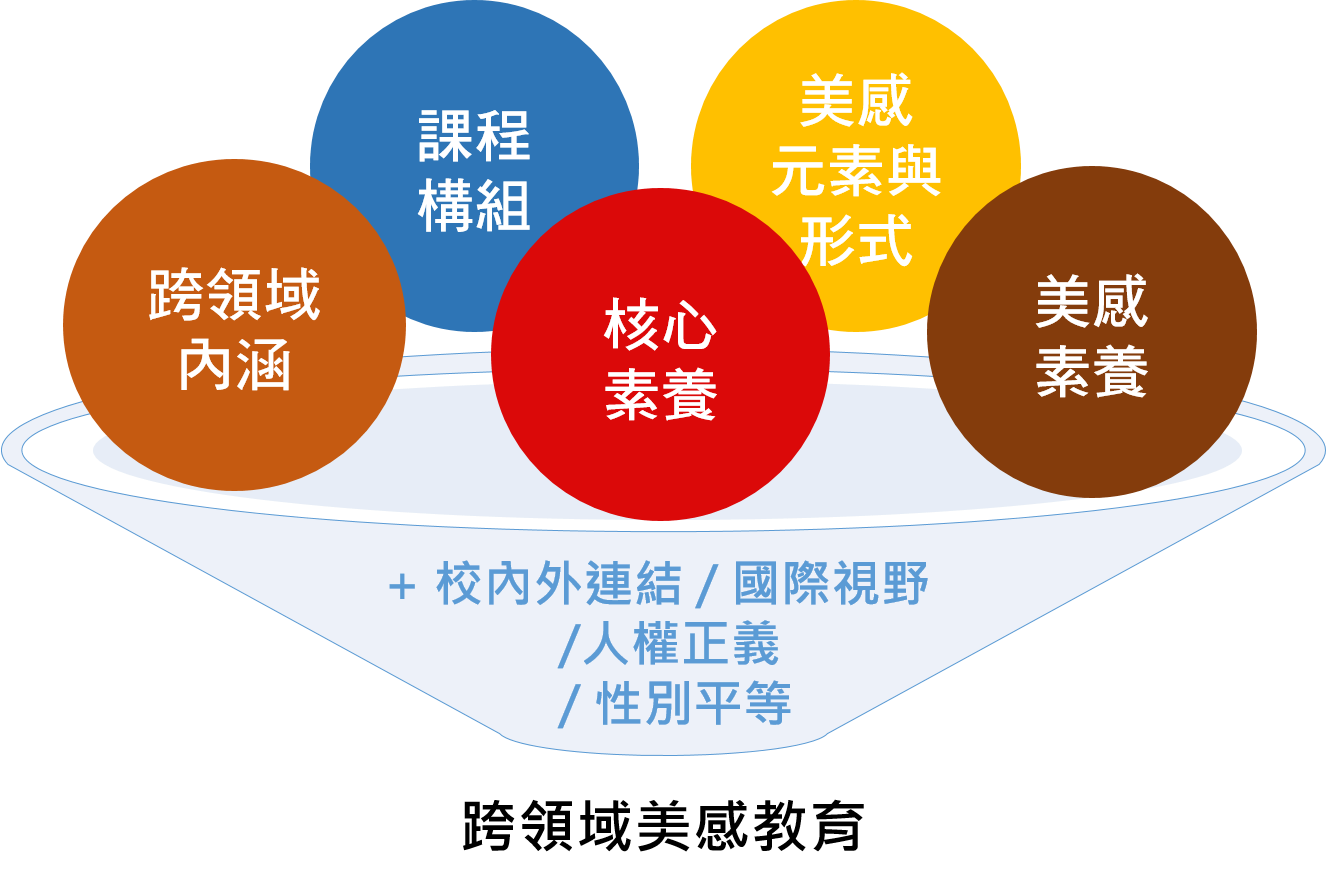Creation and innovation of cross-field aesthetic education course modules
Project host Professor Zhao Huiling, Department of Fine Arts, National Taiwan Normal University
Project co-host Professor Huang Chunmin, Department of Education, National Taiwan Normal University
Project co-host Professor Gao Zhenfeng, Department of Visual Arts, Taipei City University
1. The development and types of cross-field aesthetic course modules
The development and design of cross-disciplinary aesthetic courses include art and non-art parts. According to Jensenius (2012), when exploring the possibility of combining different disciplines, in addition to "intradisciplinary", four types were proposed, namely: "crossdisciplinary" (crossdisciplinary), "multidisciplinary" (multidisciplinary), "interdisciplinary integration" (interdisciplinary) and "transdisciplinary" (transdisciplinary), as shown in Figure 1. The latter two can achieve curriculum integration in both form and substantive content, especially the transdisciplinary type, which has almost no subject distinctions and creates themes that transcend the boundaries and knowledge patterns of each discipline. It is actually a thematic course (Huang Chunmin, 2020).
From the first to the second phase (2014-2018) of the cross-disciplinary aesthetic education project, more than 400 curriculum plans have been developed, and teachers from all over Taiwan are constantly creating and experimenting in their own educational contexts. It was in the experimental stage at that time, so the curriculum plan was freely created.
Later, the planning team gradually summarized from many plans and found that there are at least five types of cross-field aesthetic courses, namely activation courses, intersectional courses, topic-based courses, school-based courses, and window-based courses. The first type, activation courses, applies artistic knowledge, strategies, resources and activities, etc. to assist and activate the teaching of non-art subjects; the second type, intersection courses, gathers the knowledge structure or aesthetic commonality at the intersection of non-art subjects and art fields. nature; the third, issue-based curriculum, uses the relationship between the art field, social culture, environmental ecology, etc. to develop multicultural issue courses; the fourth, school-based curriculum, school-based development includes school-based courses, special courses, and flexible courses , theme courses, community courses, etc.; the fifth type, out-of-window courses, is conducted in the form of other non-school courses that focus on local arts and cultural activities, environmental ecology, media characteristics, international visits, etc.
The curriculum plans of the first five years may not have the concept of curriculum modules, but there are vague prototypes of cultivation. Starting from 2019, the team spent eight months to a year to combine these five forms with the key connotations of the 12-year national education, curriculum theory, and module concepts to further refine it into a systematic cross-field aesthetic education. Course modules.
A module is defined as a special-purpose component composed of several components with different functions. Therefore, the course module contains several course components with different teaching functions. After selection and combination, a course plan with unique teaching objectives can be formed, and the continuous course plan forms a teaching system. Ideally, after the course module is formed, if there is a need to adjust or modify the course plan, this can be achieved by adjusting different components of the course. The "Cross-Domain Aesthetics Course Module" is an organic course format composed of components of the Cross-Domain Aesthetics Course Module.
Taking a car as an analogy, air intake, fuel, exhaust, cooling, starting and other components make up the "engine" component. By assembling different components such as the engine, transmission, and body, a fully functional "car" can be completed. If the car module is assembled with "function" parameters added to it, there will be systems with different functional orientations such as passenger cars, trucks, and buses for personal use. Modules usually have the same process and logic, but by changing the components, their functions and uses can be adjusted. This means that when the environmental context is different, we can adjust the component parameters in a timely manner to form a functional module that conforms to the corresponding context, so it It’s very elastic and organic.
2. The role and advantages of the cross-field aesthetic course module
Each course module is organically assembled and becomes a functional system that can meet three needs. First, the abilities that learners should cultivate are the main considerations in course design and organization; second, there can be various teaching activities within a course module, but they all aim at cultivating specific abilities; third, each course module The group must be able to develop specific core competencies or abilities that students need.
The course module looks at the context of the teaching situation and considers each parameter or variable to derive the major course components. Large components are like wheels that are indispensable for a car. Teachers should think about "what are the indispensable core components" of the course, design accordingly, and then develop small components or elements below the large components. Such a course module can better respond to the variables or parameters of the education scene to meet the learning needs of students, and teachers can also "create courses". In this way, teachers' initiative in developing courses and creating courses can be exerted from the bottom up, regardless of national or The top-down institutional framework of the Ministry of Education.
The course modules are organically flexible. They can not only customize the abilities of learners in response to teaching needs, but also adjust component composition according to educational trends, strengthen academic connections, promote cross-field teaching and learning methods for teachers and students, and integrate knowledge. It is a systematic course that responds to more diverse teaching forms and assessment methods. Possible parameters of the cross-field aesthetic course module include: different disciplines (art and non-art), schools (such as mountains, seas, urban and rural areas), educational stages (such as grades 1-16 from primary school to senior year), regions (such as southeast, northwest and outlying islands) ), community culture, local and international, as well as physical and virtual, etc., can all be used flexibly and combined organically to create courses.
It is worth noting that organic curriculum modules are formed according to the context of the site and student needs. It is quite flexible, but it is not chaotic. Teachers still need to have the ability to develop curriculum and module assembly. Only with the core concept can they develop curriculum objectives. . Accordingly, the cross-field aesthetics course module has the following advantages. First, it is based on abilities. Each module can be customized to cultivate relevant abilities such as aesthetics in response to teaching and learning needs. Secondly, it is organically flexible and visualizes education trends. , teaching site and learning needs, flexibly adjust components such as cross-field course design; third, strengthen the connection between physics and practice, gather all relevant knowledge, integrate it into unified learning content, and transform it into practical wisdom; Fourth, the teaching and assessment forms are diverse, and the integrated learning content emphasizes the deepening and transformation of meaning in the learning process, making good use of multiple assessments such as file assessment, practical assessment, and real assessment... etc., which is more in line with the cultivation of aesthetic literacy.
3. Components of the cross-field aesthetic course module
After the planning team brainstormed and consulted the opinions of on-site teachers, the cross-field beauty course module has been upgraded from version 1.0 in 2019 to version 3.0 in 2021. It includes five indispensable elements: cross-field connotation, aesthetic elements and aesthetic forms, cross-field aesthetic literacy, cross-field core literacy, cross-field aesthetic course structure, and four outstanding highlights: connections inside and outside the school, international perspective, Human rights justice, gender equality. The schematic diagram of the cross-field aesthetic education course module is shown in Figure 2.
(1) Cross-field connotation
According to the course objectives and course type, select the knowledge (ability) connotation of art and non-art subjects/fields, such as specific concepts, topics, teaching units, or multiple issues, themes, etc.
(2) Aesthetic elements and aesthetic forms
Based on the course objectives, select art and non-art subjects/fields to develop and apply components that can be connected with aesthetic elements and forms, such as creative expression, appreciation and practice and other artistic activities.
1. Aesthetic element components
Visual art: points, lines, surfaces, space, composition, texture, color, light and shade, etc.
Music: rhythm, melody, timbre, dynamics, texture, musical form, etc.
Performing Arts: Elements of drama or dance such as sound, body, emotion, time, space, energy, improvisation, movement, theme, etc.
2. Aesthetic form components
Balance, harmony, contrast, gradation, proportion, rhythm, rhythm, repetition, order, unity, simplicity, virtual reality, specificity, etc.
(3) Cross-field aesthetic literacy
Based on the course objectives, choose cross-field aesthetic literacy.
1. Aesthetic thinking and awareness and reflection: discover one’s own positioning and identity through reflection and introspection of aesthetic knowledge.
2. Design thinking and creative thinking: Cultivate the habit of being creative and solving problems with concrete plans
3. Art exploration and life practice: Cultivate the habit of exploring artistic activities and apply relevant knowledge in daily life.
4. Symbol recognition and context application: identify and understand symbol styles and meanings and use them appropriately.
5. Digital media and network mastery: Master digital technology media and be able to understand and evaluate online information.
6. Artistic participation and social action: Plan artistic activities and use them to express participation in society.
7. Cross-domain culture and diverse interpretation: Understand cultural diversity and be able to try to interpret the connotation of issues.
(4) Cross-field core competencies
Based on the curriculum objectives, the corresponding core competencies in the art field and cross-field/subject core competencies are selected from the 12-year national basic education syllabus in each field.
(5) Cross-field aesthetic course structure
According to the curriculum objectives, it is composed of curriculum sub-components with cross-field aesthetic characteristics, including curriculum objectives, teaching material content, teaching activities, teaching strategies, teaching resources, and learning evaluation.
The first emphasis on cross-field is "cross-field connotation", from science, technology, engineering, mathematics (STEM) to art (Art) to become STEAM. In recent years, based on STEAM, plus humanities (humanities), it has been reorganized into THEMAS, science and technology. Interdisciplinary integration tends to be more thematic teaching. In terms of aesthetic education, ikebana in Japanese culture is an example. In the process of selecting flower materials and creating flower arrangements, in addition to beautiful elements and beautiful forms, it also emphasizes the natural state of the integration of body, mind and soul. It is an integral part of the culture. The harmonious beauty and spiritual beauty.
In the teaching design, "aesthetic elements and aesthetic forms" corresponding to visual arts, performing arts, and music are combined. The content not only inherits the "cross-field core competencies" of the 12-year national education general outline and program, but also focuses on how to integrate art and music. Cross-domain between non-arts, further add "cross-domain aesthetic literacy", and construct a specific and feasible curriculum plan in the design concept. In addition, even the traditional Taylor Engineering curriculum development model, as well as the subsequent processual curriculum development model, or design development model, all involve: curriculum objectives, teaching material content, teaching activities, teaching strategies, teaching resources, learning assessment, etc. " "Cross-disciplinary aesthetic course structure", linking the selection of materials and organizing activities to the course objectives, and thinking about what resources need to be incorporated and what kind of multi-evaluation needs to be done are all things that must be dealt with in teaching practice and are also the basis for curriculum development.

Figure 3 Schematic diagram of the core connotation of the cross-field aesthetic education course module
The cross-domain aesthetic education course module is not a closed state. Its core connotation is shown in Figure 3. The cross-sectional connections and processing processes between the components are related to whether the cross-domain quality of the course is refined or not. When the parameters are different, the emphasized components are also different, which can be customized to meet the needs of the course, improving the accuracy, solidity, and flexibility of the course; at the same time, integrating systematic courses to cope with diverse teaching and assessment, and strengthening academic link.
As for the outstanding highlight of the cross-disciplinary beauty education course module, it is the connection inside and outside the school. It hopes to connect the school and the community and use social beauty resources to see the beauty in life. In 2019, the planning team organized more than twenty cross-regional day study sessions across Taiwan. For teachers, its significance lies in expanding the areas where teaching within the school walls is insufficient; for students, it lies in confirming what the school has learned, observing, examining, and digesting it. , internalize and apply; for parents, they can understand what the school is doing and what the characteristics of the community are.
Highlights of Excellence 2: International Perspective, which is specifically mentioned in the 12-year core competencies of the national education, aims to reflect the cross-field aesthetic education curriculum emphasizing "cross-boundary" and "crossing borders" ( transborder) perspective to enhance the diverse literacy capabilities of students and teachers. The connections inside and outside the school and the international perspective not only allow the learning content to be glocalized and respond to globalization in place, but also under the two-way and multi-directional transformation of cultural interaction, learning can also be "local globalization" ( Localgloblization), curriculum innovation and practical wisdom that contextualize cross-field aesthetic education in Taiwan have also been transformed into "Taiwanese localgloblization" (Huang Chunmin, 2020).
Highlights three and four are two new highlights added by the project team in 2021. Human rights, justice and gender equality have particularly highlighted their importance in recent world situations. In 2019, Taiwan's "Judicial Yuan Interpretation and Enforcement Law No. 748" passed the third reading, opening a new chapter in same-sex marriage; in 2019, the anti-extradition incident in Hong Kong; in 2020, "little boys dare not wear pink masks to school" in Taiwan Gaining attention from all walks of life; the 2021 Afghan coup refugee wave and related events have formed educational inspirations through life and media, and are also reflected in the curriculum plans of cross-field aesthetic education over the years. In terms of human rights and justice, we hope that through cross-domain aesthetic courses, we can integrate the knowledge of universal human rights, promote the understanding and practice of respect, tolerance and responsibility, and take positive actions to protect/fight for human rights and freedoms. In terms of gender equality, we provide integrated teaching of knowledge, affective attitudes, and motor skills on issues such as gender diversity, gender literacy, gender rights, and emotional education, and promote dialogue and consensus on gender and other multicultural issues.
4. The creation and practical value of the cross-field aesthetic course module
Based on the eight years (2014-2021) of cross-field aesthetic education, nearly 900 course plans have been accumulated. It can be seen that the application and practice of cross-field aesthetic course modules are quite diverse and flexible, and can be based on different learning stages, different disciplines, etc. , the components are adjusted so that the cross-field aesthetic course module can meet the needs of the teaching site, making cross-field aesthetic education easier and enriching students' learning experience. The following explains the creation and practical value of the cross-field aesthetic course module in terms of curriculum development, teaching practice, and student learning.
First of all, in terms of curriculum development,The design of the cross-field aesthetic course module consists of five components and four outstanding highlights. In the component part, art, non-art subjects, and aesthetic education are integrated, and the core competencies corresponding to the 12-year national education are added. Finally, the curriculum structure required for curriculum development is added. Therefore, when selecting a combination of components, we have gradually moved towards a cross-field aesthetic education course plan. There is no need to think about how the classroom crosses fields, and how the courses that incorporate aesthetic education should be presented. Moreover, when using the cross-field aesthetic course module, adding four outstanding highlights: connections inside and outside the school, international perspective, human rights and freedoms, and gender equality can further deepen the course and make it more distinctive.
Judging from the current development status of domestic course modules, the cross-field aesthetic course module can be said to be a highly complete, flexible and diverse course module. The cross-field aesthetic course module can be adjusted according to actual needs by adding different parameters or variables. It can be developed into a small unit course or expanded into a topic-based course. In addition, the cross-field aesthetic course module itself is designed to cover literacy/ability, and it can be used as a literacy course module no matter how it is adjusted or changed.
The 12-year state education emphasizes teachers’ cross-field, topic-integrated, and literacy-oriented courses. The cross-field aesthetic course module can include the above-mentioned items, which is conducive to teachers’ curriculum development and the cultivation of aesthetic education in the module. , which is rarely seen in China at present.
In terms of teaching practice, teachers use cross-field aesthetic course modules to develop a set of course plans exclusive to learners, and then implement them at the teaching site. Therefore, the course module can also be a teaching module. Because the cross-disciplinary aesthetic course module is flexible, each component can be reassembled. During the implementation process, teachers can adjust the components after class through observation lessons, meta-cognition, or feedback from parents and learners. The combination makes the cross-field aesthetic course module more suitable for teaching objects. Through continuous practice and reorganization, the cross-field aesthetic course module is more perfect and easier to achieve teaching goals.
In terms of student learning, the cross-field aesthetic course module itself is a course module that contains cross-field, aesthetic education, topic integration, and literacy orientation. It is quite suitable for the current teaching scene of the 12-year national education. Teachers develop and implement courses through cross-field aesthetic course modules, and learners can experience a more complete learning process. Therefore, course modules can also be learning modules.
The cross-field aesthetic course module combines art subjects and non-art subjects so that the subjects can be used, combined and learned more effectively. In the past, aesthetic education was often a neglected "frontier" part of the discipline. Overemphasis was placed on intellectual education, which failed to enable learners to become a "complete person." Through the development of courses through cross-field aesthetic course modules, aesthetic education is integrated into the curriculum, allowing learners to realize through the five senses and six senses that aesthetic education is not absent, but omnipresent, in every corner and every moment of life. It can be part of the perception of beauty.
Cross-field learning, the integration of topics, and literacy orientation allow learners to adapt to the rapidly changing space-time environment of today's rapidly developing technology, regardless of whether it is physical or virtual, and better understand how to become "human beings". ” of ordinary life and beauty.
It can be seen that the value of the cross-field aesthetic course module includes: facilitating teacher course creation and development, flexible teaching and practice, expanding learners’ learning experience and cultivating adaptability, improving learners’ educational process, etc.
5. Conclusion
Since the implementation of the 12th National Education Curriculum in 2019, teachers have been constantly seeking ways to improve or re-create the curriculum, whether through studies, lectures or workshops, in the hope of providing learners with the best curriculum content. The Ministry of Education's cross-field aesthetic education excellence pilot project has developed a cross-field aesthetic course module through experiments, designs and trials, combining theory and practice, and cooperating with on-site teachers. Teachers in each school can use five components plus four This is an outstanding highlight, combined with cross-field, topic integration, literacy-oriented and other orientations, to create a flexible and diverse cross-field aesthetic course to provide learners with a richer learning experience. As the cross-domain beauty course module continues to be promoted in teaching sites across Taiwan, we will continue to collect implementation feedback to refine and advance the cross-domain beauty course module.





